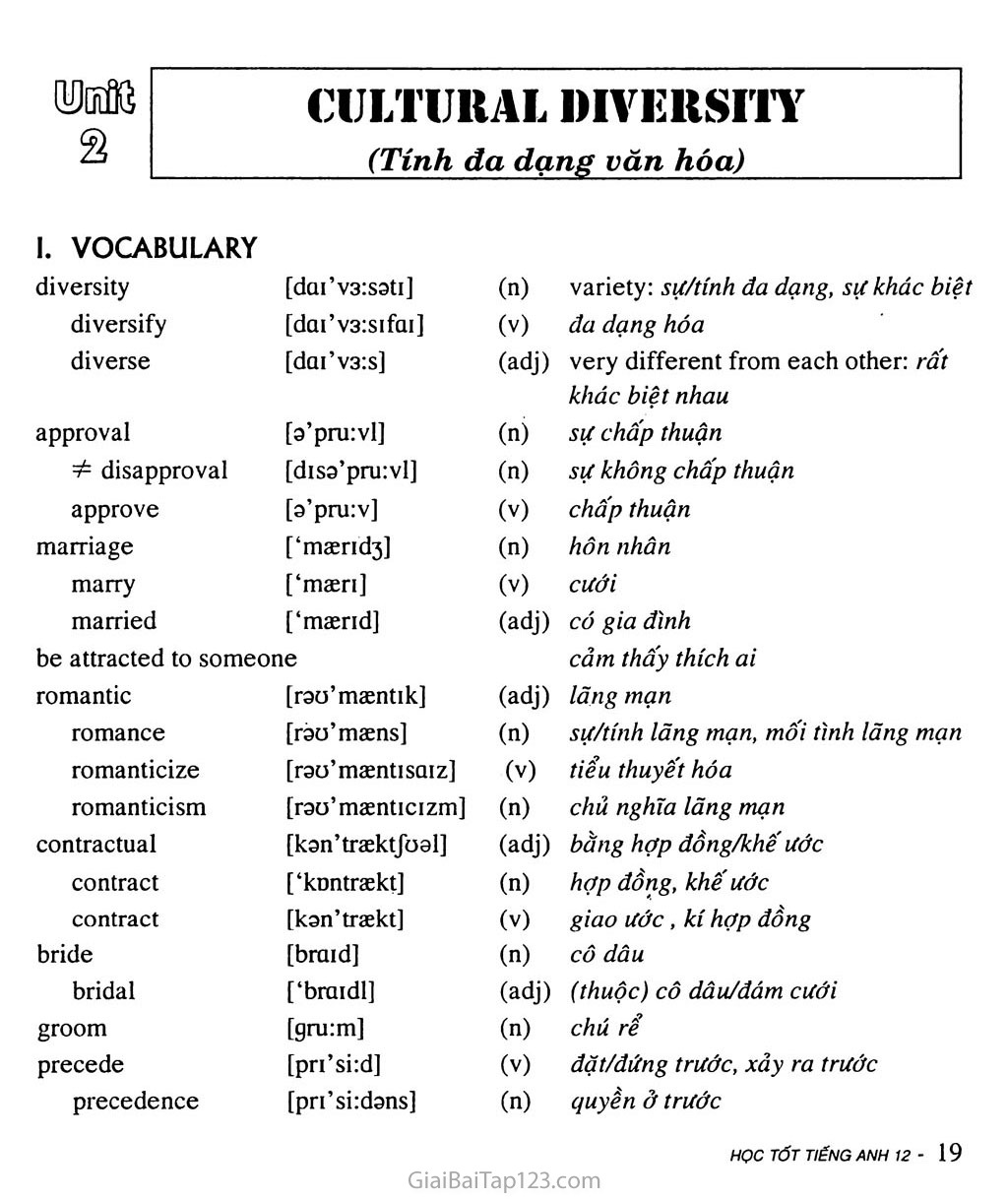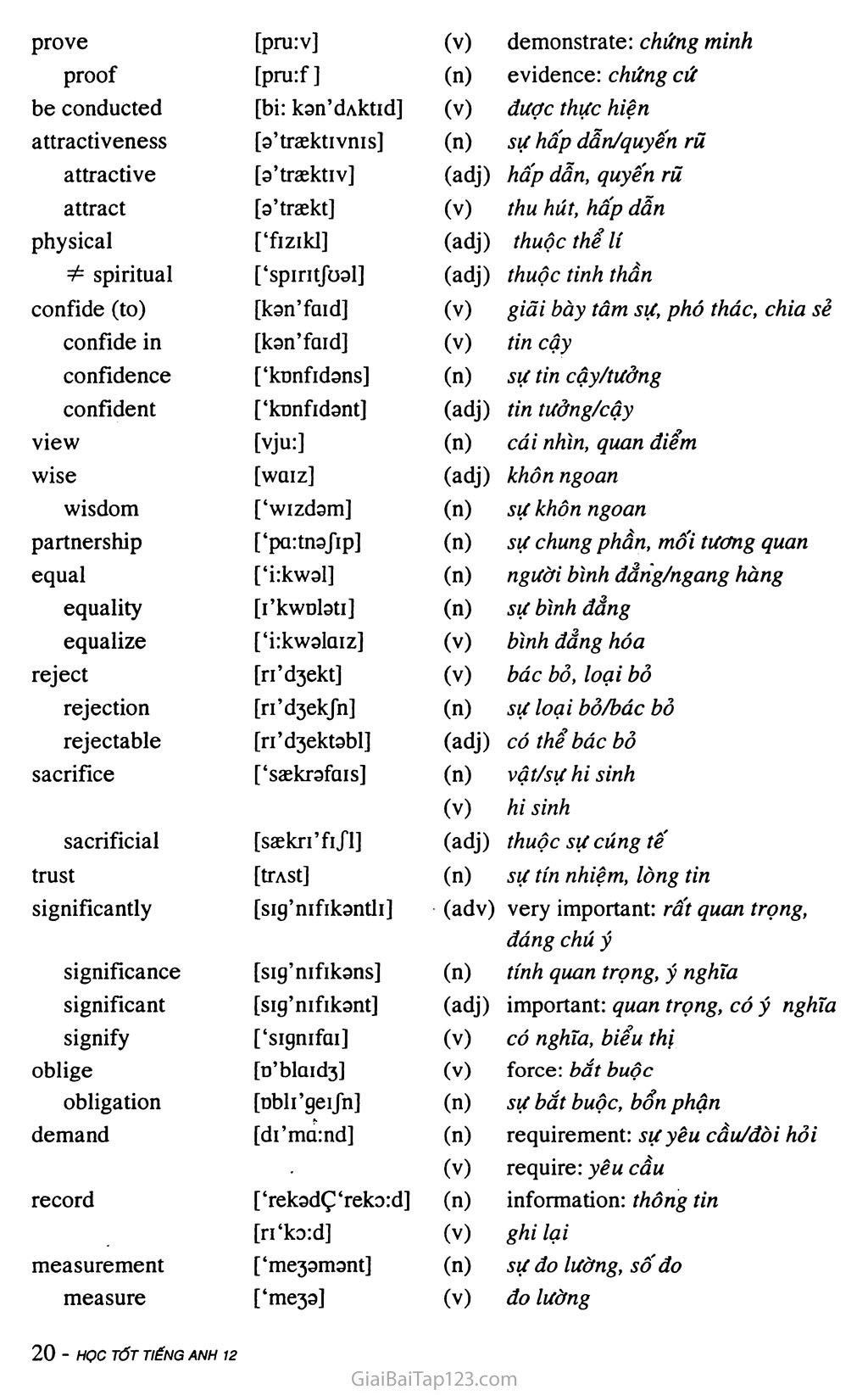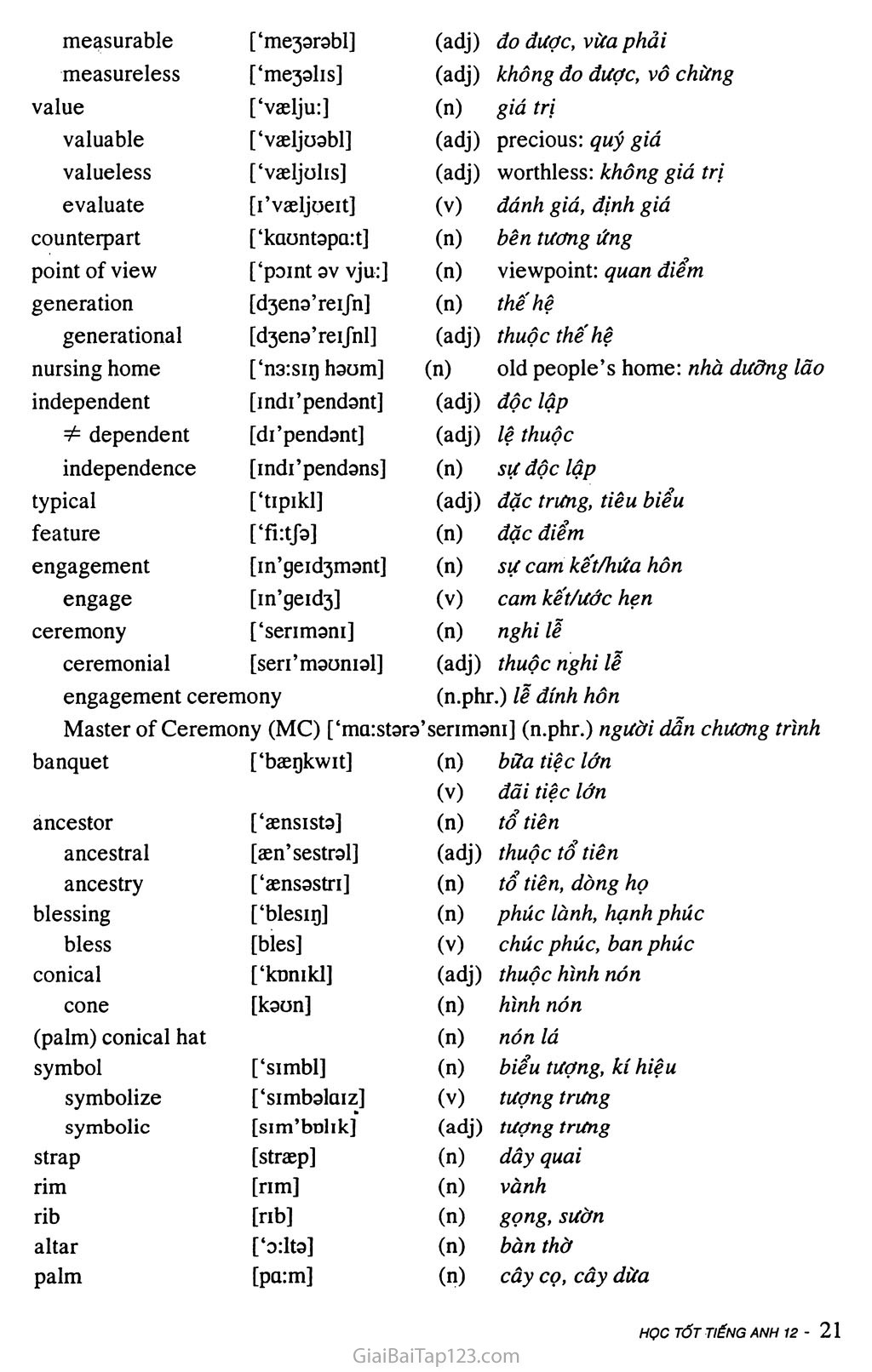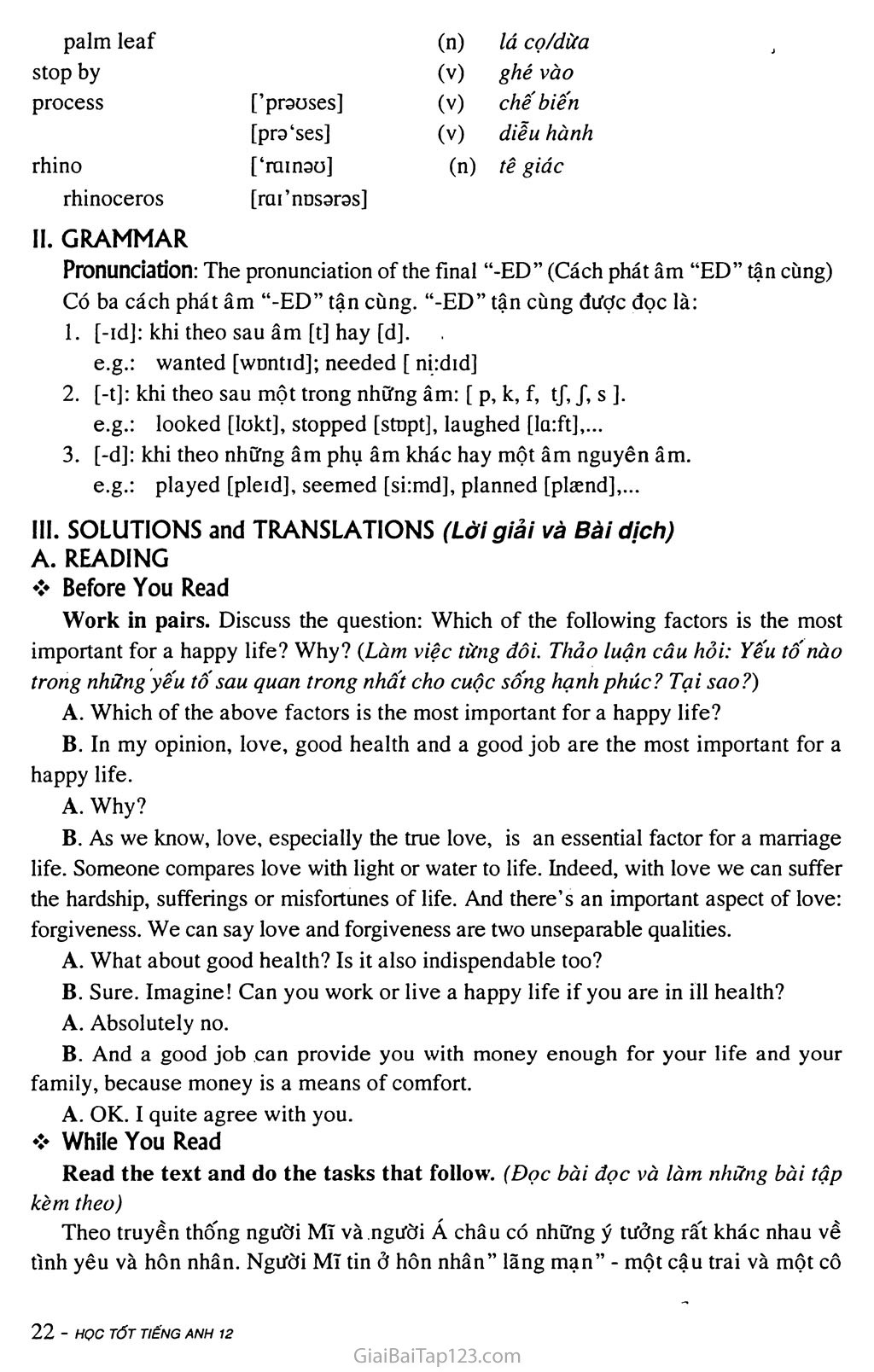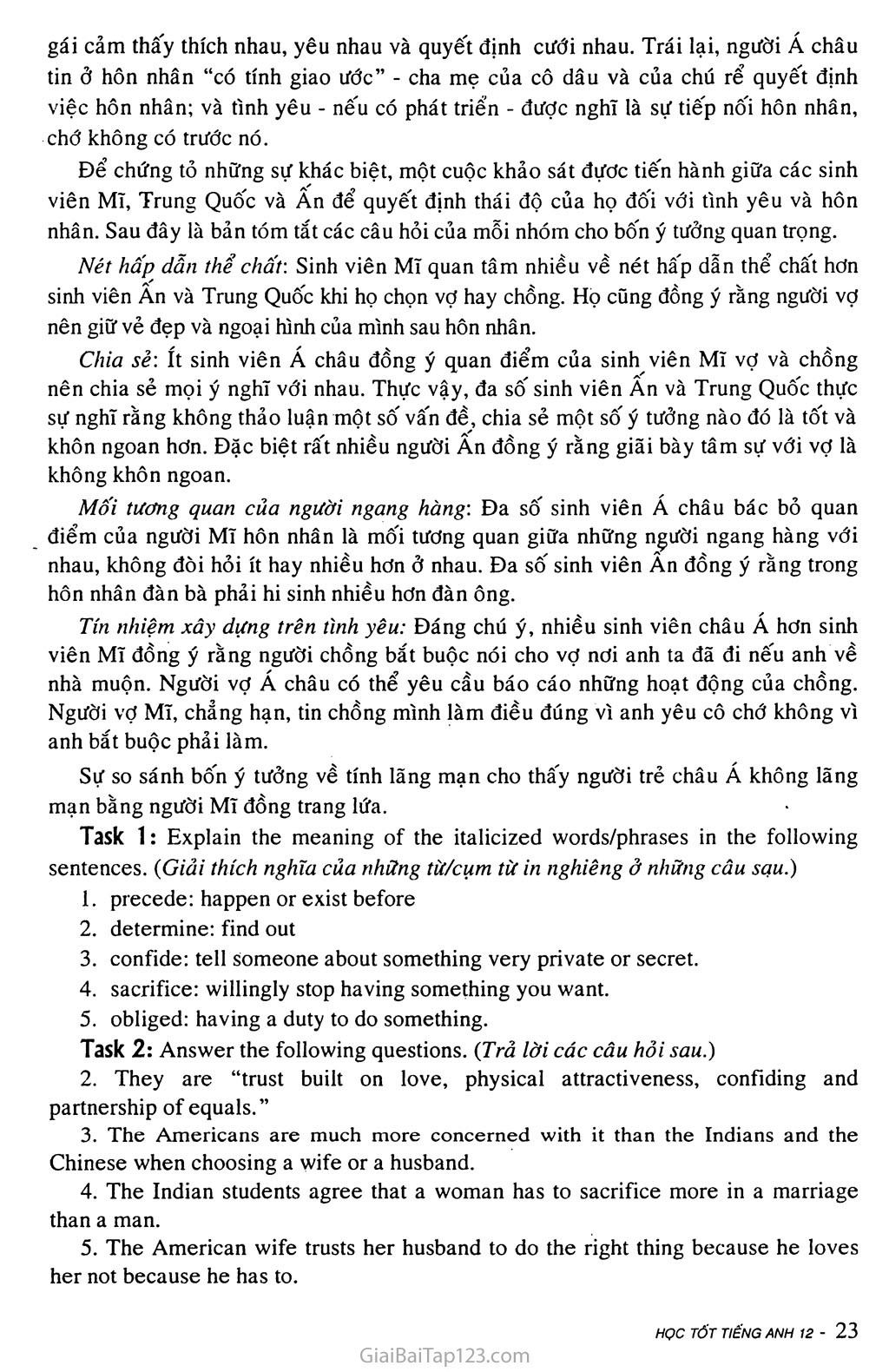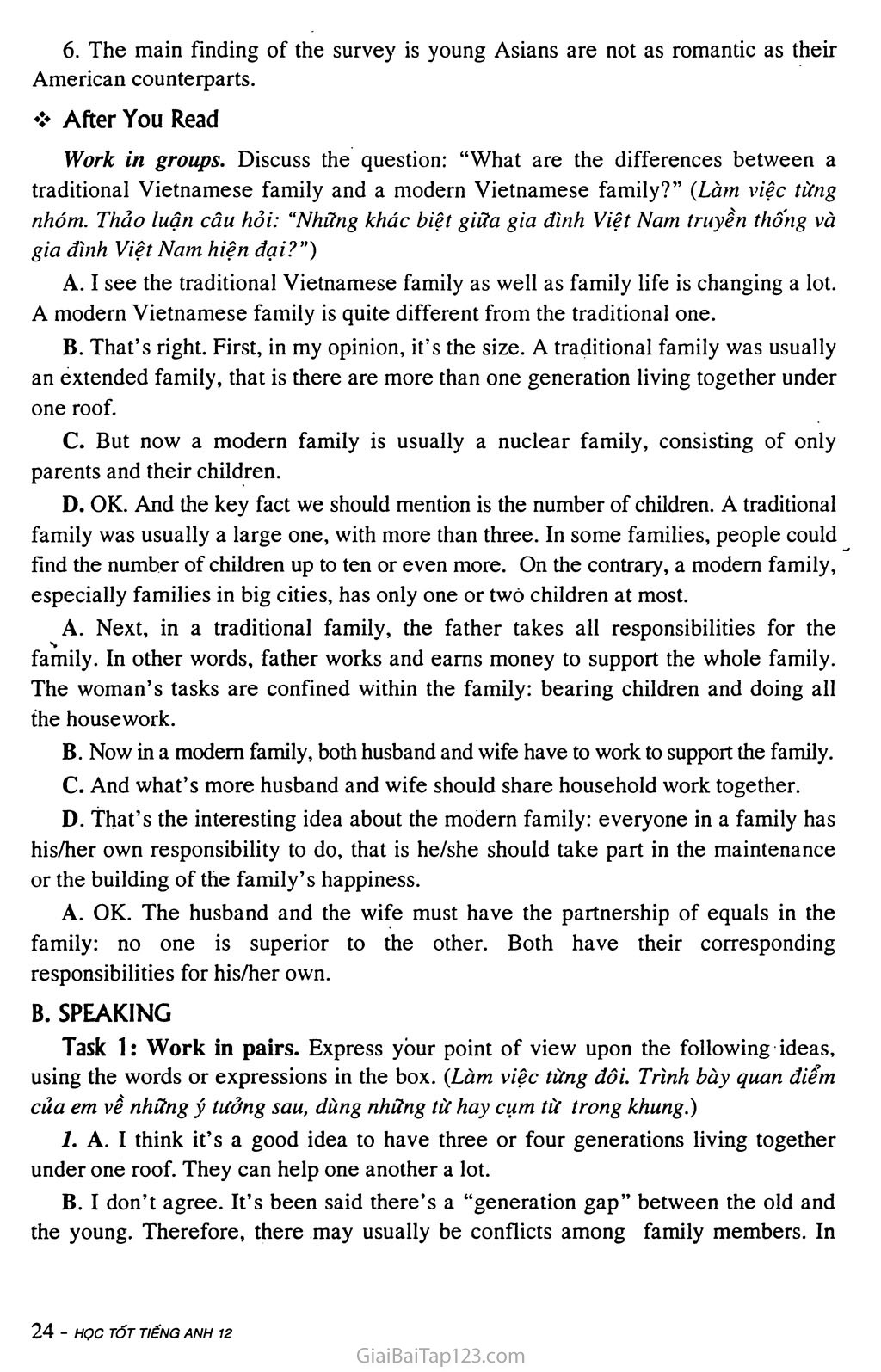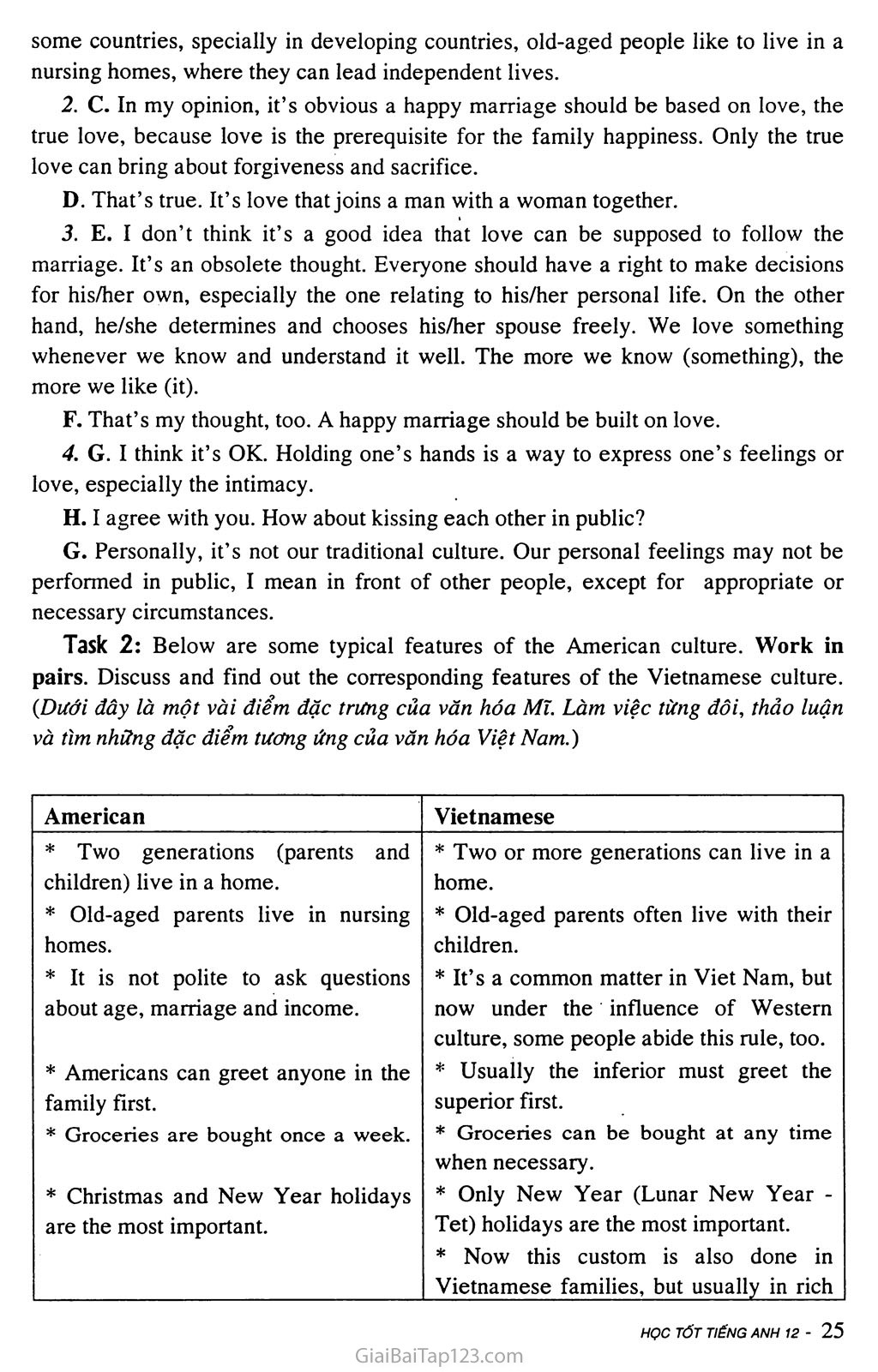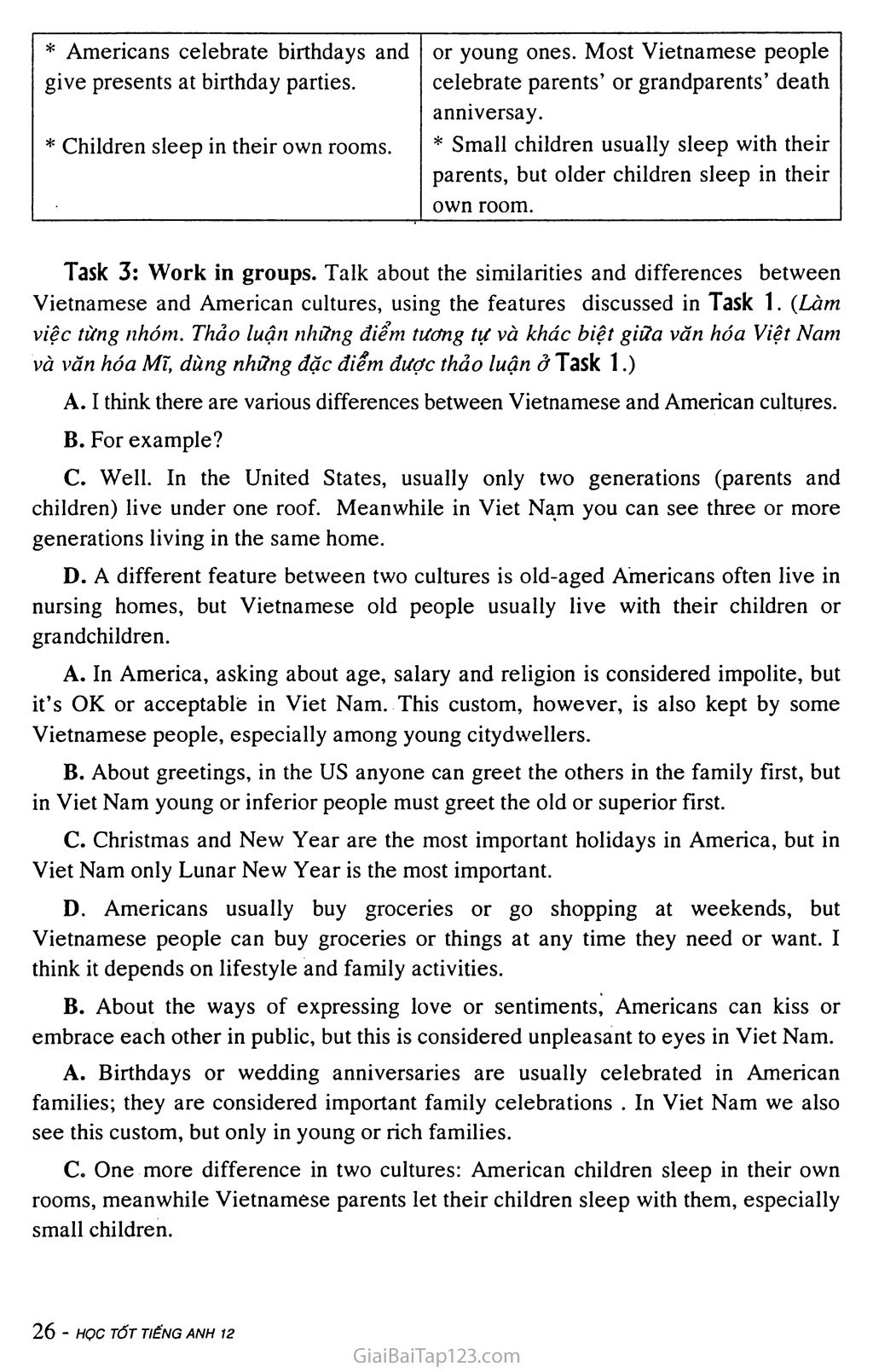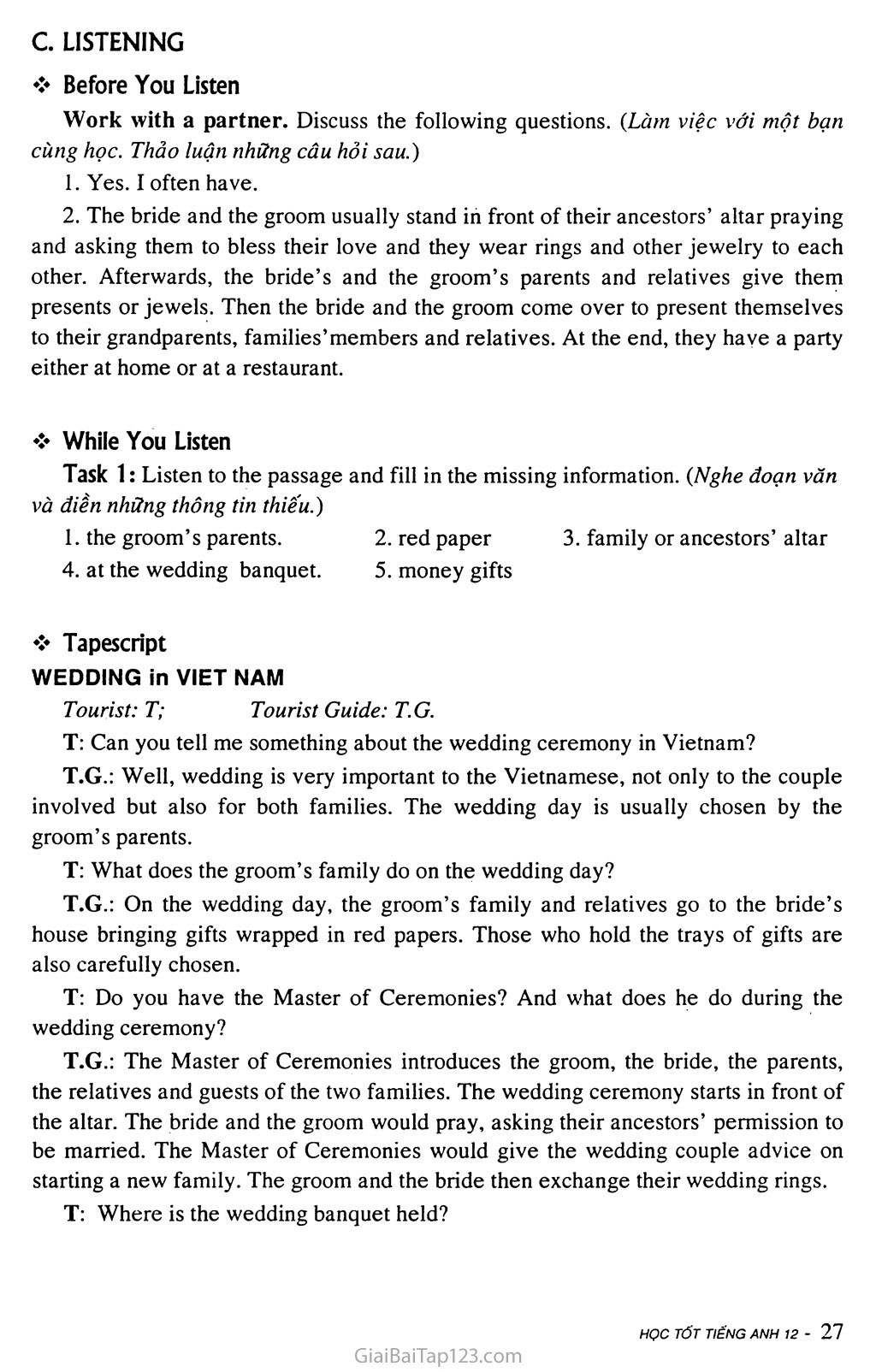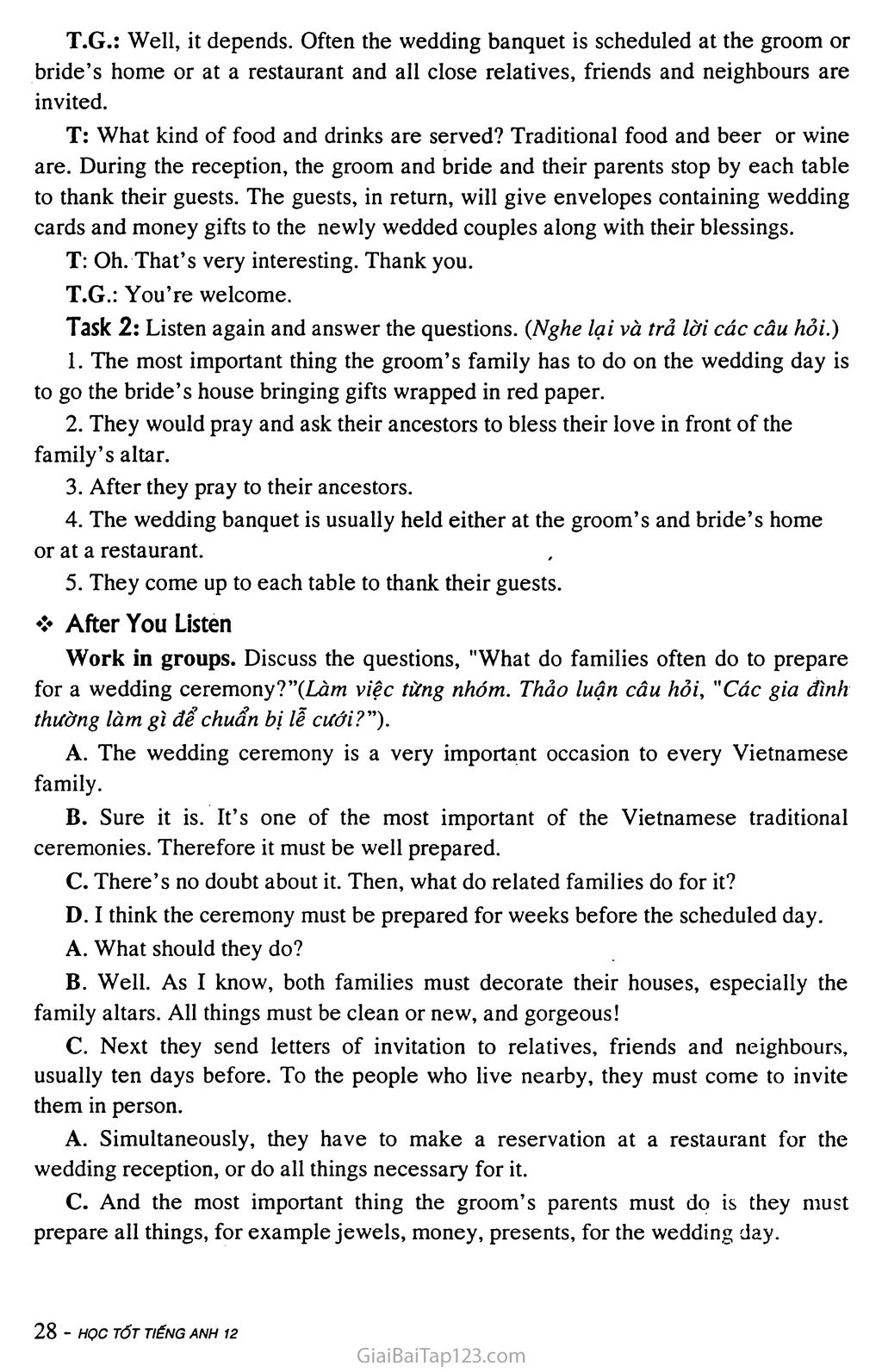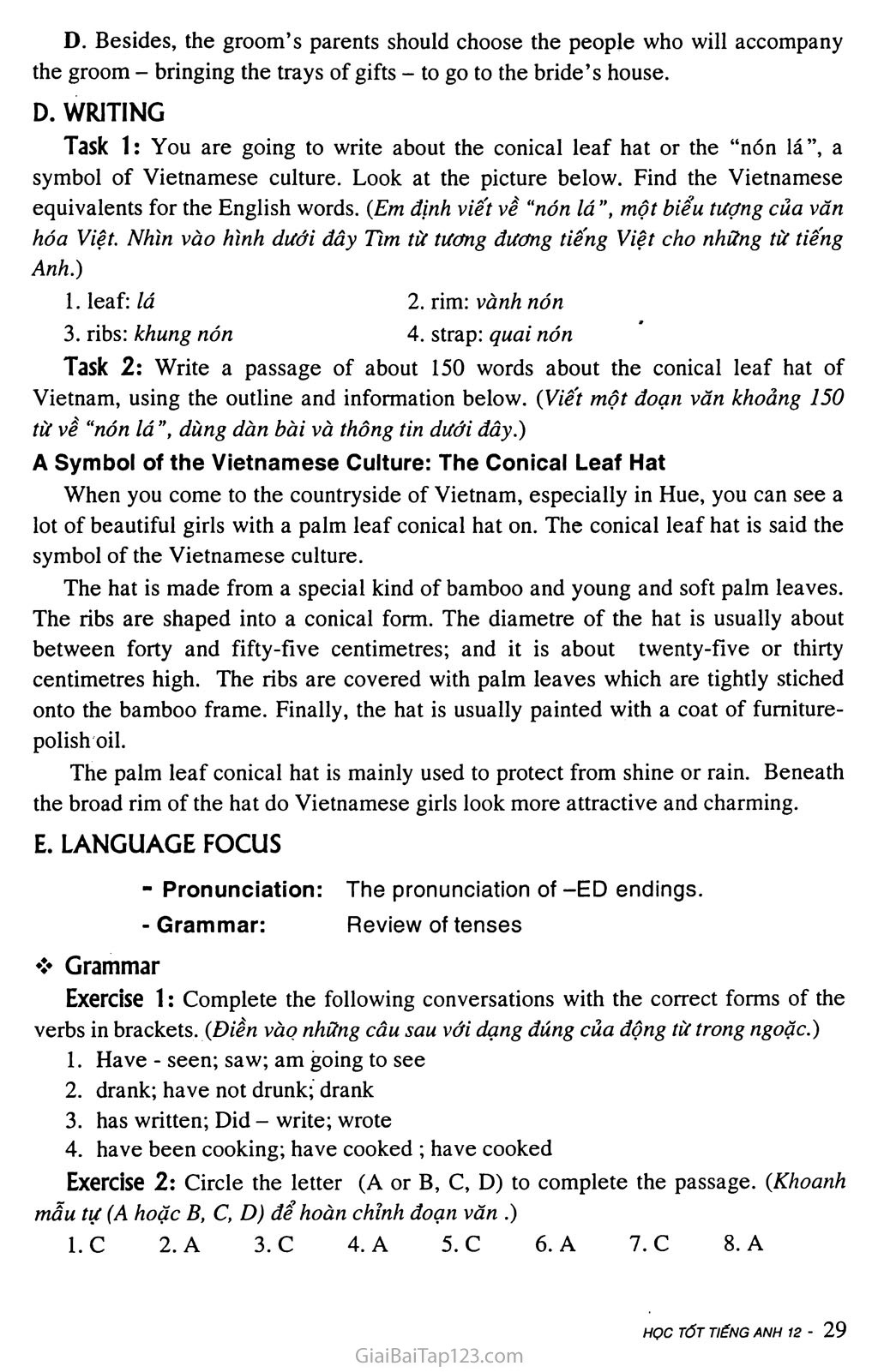Giải tiếng Anh lớp 12 Unit 2: CULTURAL DIVERSITY
CULTURAL DIVERSITY
(Tính đa dạng văn hóa)
I. VOCABULARY
diversity
[dm’v3:s3ti]
(n)
variety: sự/tính da dạng, sự khác biệt
diversify
[dai’v3:sifai]
(V)
đa dạng hóa
diverse
[dai’v3:s]
(adj)
very different from each other: rất khác biệt nhau
approval
[o’pnrvl]
(n)
sự chấp thuận
#= disapproval
[disa’pru:vl]
(n)
sự không chấp thuận
approve
[a’pru:v]
(V)
chấp thuận
marriage
[‘maerid3]
(n)
hôn nhân
marry
[‘maeri]
(V)
cưới
married
[‘mserid]
(adj)
có gia đình
be attracted to someone
cảm thấy thích ai
romantic
[rao’masntik]
(adj)
lãng mạn
romance
[reo’maens]
(n)
sự/tính lãng mạn, mối tình lãng mạn
romanticize
[rao’msentisaiz]
(V)
tiểu thuyết hóa
romanticism
[rao’masnticizm]
(n)
chủ nghĩa lãng mạn
contractual
[kan’traektfoal]
(adj)
bằng hợp đồng/khế ước
contract
[‘kDntraskt]
(n)
hợp đồng, khế ước
contract
[ksn’trrekt]
(V)
giao ước, kí hợp đồng
bride
[braid]
(n)
cô dâu
bridal
[‘braidl]
(adj)
(thuộc) cô dâu/đám cưới
groom
[gru:m]
(n)
chú rể
precede
[pri’si:d]
(V)
đặt/đứng trước, xảy ra trước
precedence
[pri’skdans]
(n)
quyền ở trước
prove
[pru:v]
(V)
demonstrate: chứng minh
proof
[pru:f]
(n)
evidence: chứng cứ
be conducted
[bi: kan’dAktid]
(V)
được thực hiện
attractiveness
[a’trasktivms]
(n)
sự hấp dẫn/quyến rũ
attractive
[a’trasktiv]
(adj)
hấp dẫn, quyến rũ
attract
[a’traekt]
(V)
thu hút, hấp dẫn
physical
[‘fizikl]
(adj)
thuộc thể lí
=# spiritual
[‘spiritjbal]
(adj)
thuộc tinh thần
confide (to)
[kan’faid]
(V)
giãi bày tâm sự, phó thác, chia sẻ
confide in
[kan’faid]
(V)
tin cậy
confidence
[‘kDnfidans]
(n)
sự tin cậy/tưởng
confident
[‘knnfidant]
(adj)
tin tưởng/cậy
view
[vju:]
(n)
cái nhìn, quan điểm
wise
[waiz]
(adj)
khôn ngoan
wisdom
[‘wizdam]
(n)
sự khôn ngoan
partnership
[‘pa:tnajip]
(n)
sự chung phần, mối tương quan
equal
[li:kwal]
(n)
người bình đẳrig/ngang hàng
equality
[I’kwnlati]
(n)
sự binh đẳng
equalize
[li:kwalaiz]
(V)
bình đẳng hóa
reject
[rfd3ekt]
(V)
bác bỏ, loại bỏ
rejection
[ri’d3ekjn]
(n)
sự loại bỏ/bác bỏ
rejectable
[ri’d3ektabl]
(adj)
có thể bác bỏ
sacrifice
[‘saskrafais]
(n)
(V)
vật/sự hi sinh
hi sinh
sacrificial
[saekri’flji]
(adj)
thuộc sự cúng tê'
trust
[tTASt]
(n)
sự tín nhiệm, lòng tin
significantly
[sig’nifikantli]
(adv) very important: rất quan trọng, đáng chú ý
significance
[sig’nifikans]
(n)
tính quan trọng, ý nghĩa
significant
[sig’mfikant]
(adj)
important: quan trọng, có ý nghĩa
signify
[‘sigmfai]
(V)
có nghĩa, biểu thị
oblige
[n’blaid3]
(V)
force: bắt buộc
obligation
[nbli’geifn]
(n)
sự bắt buộc, bổn phận
demand
[di’ma:nd]
(n)
(V)
requirement: sự yêu cầu/đòi hỏi require: yêu cầu
record
[lrekadỌ‘reka:d]
[ri‘ka:d]
(n)
(V)
information: thông tin ghi lại
measurement
[*me3amant]
(n)
sự đo lường, số đo
measure
[lme3a]
(V)
đo lường
measurable
[lme3arabl]
(adj)
đo được, vừa phải
measureless
[‘me3alis]
(adj)
không đo được, vô chừng
value
[‘vaelju:]
(n)
giá trị
valuable
[‘vasljoabl]
(adj)
precious: quý giá
valueless
[‘vasljolis]
(adj)
worthless: không giá trị
evaluate
[I’vaeljoeit]
(V)
đánh giá, định giá
counterpart
[‘kaontapn:t]
(n)
bên tương ứng
point of view
[‘point av vju:]
(n)
viewpoint: quan điểm
generation
[d3ena’reijn]
(n)
thê' hệ
generational
[d3ena’reijnl]
(adj)
thuộc thế hệ
nursing home
[‘n3:sir) haom]
(n)
old people’s home: nhà dưỡng lão
independent
[indi’pendant]
(adj)
độc lập
dependent
[di’pendant]
(adj)
lệ thuộc
independence
[indl’pendans]
(n)
sự độc lập
typical
[‘tipikl]
(adj)
đặc trưng, tiêu biểu
feature
[Ti:t;a]
(n)
đặc điểm
engagement
[in’geid3mant]
(n)
sự cam kết/hứa hôn
engage
[in’geid3]
(V)
cam kết/ước hẹn
ceremony
[‘serimam]
(n)
nghi lễ
ceremonial
[seri’maomal]
(adj)
thuộc nghi lễ
engagement ceremony (n.phr.) lễ đính hôn
Master of Ceremony (MC) [‘ma:stara’serimani] (n.phr.) người dẫn chương trình
banquet
[‘baegkwit]
(n)
(V)
bữa tiệc lớn đãi tiệc lớn
ancestor
[‘asnsista]
(n)
tô tiên
ancestral
[aen’sestral]
(adj)
thuộc tổ tiên
ancestry
[‘aensastri]
(n)
tổ tiên, dòng họ
blessing
[‘blesirj]
(n)
phúc lành, hạnh phúc
bless
[bles]
(V)
chúc phúc, ban phúc
conical
[‘knnikl]
(adj)
thuộc hình nón
cone
[kaon]
(n)
hình nón
(palm) conical hat
(n)
nón lá
symbol
[‘simbl]
(n)
biểu tượng, kí hiệu
symbolize
[‘simbalaiz]
(V)
tượng trưng
symbolic
[sim’bolik]
(adj)
tượng trưng
strap
[straep]
(n)
dây quai
rim
[rim]
(n)
vành
rib
[nb]
(n)
gọng, sườn
altar
[*o:lta]
(n)
bàn thờ
palm
[pn:m]
(n)
cây cọ, cây dừa
palm leaf
(n)
lá cọ/dừa
stop by
(V)
ghé vào
process
[’praoses]
(V)
chế biến
[pra'ses]
(V)
diễu hành
rhino
[‘rainao]
(n)
tê giác
rhinoceros
[rai’nDsaras]
GRAMMAR
Pronunciation: The pronunciation of the final “-ED” (Cách phát âm “ED” tận cùng)
Có ba cách phát âm “-ED” tận cùng. “-ED” tận cùng được đọc là:
[-idj: khi theo sau âm [t] hay [d].
e.g.: wanted [wDntid]; needed [ ni:did]
[-t]: khi theo sau một trong những âm: [ p, k, f, ự, /, s ]. e.g.: looked [lokt], stopped [stnpt], laughed [la:ft],.„
[-d]: khi theo những âm phụ âm khác hay một âm nguyên âm. e.g.: played [pleid], seemed [si:md], planned [plaend],...
SOLUTIONS and TRANSLATIONS (Lời giải và Bài dịch)
A. READING
Before You Read
Work in pairs. Discuss the question: Which of the following factors is the most important for a happy life? Why? {Làm việc từng đôi. Thảo luận câu hỏi: Yếu tô'nào trong những yếu tô'sau quan trong nhất cho cuộc sống hạnh phúc? Tại sao?)
Which of the above factors is the most important for a happy life?
In my opinion, love, good health and a good job are the most important for a happy life.
Why?
As we know, love, especially the true love, is an essential factor for a marriage life. Someone compares love with light or water to life. Indeed, with love we can suffer the hardship, sufferings or misfortunes of life. And there’s an important aspect of love: forgiveness. We can say love and forgiveness are two unseparable qualities.
What about good health? Is it also indispendable too?
Sure. Imagine! Can you work or live a happy life if you are in ill health?
Absolutely no.
And a good job can provide you with money enough for your life and your family, because money is a means of comfort.
A. OK. I quite agree with you.
While You Read
Read the text and do the tasks that follow. (Đọc bài đọc và làm những bài tập kèm theo)
Theo truyền thông người Mĩ và người Á châu có những ý tưởng rất khác nhau về tình yêu và hôn nhân. Người Mĩ tin ở hôn nhân” lãng mạn” - một cậu trai và một cô gái cảm thây thích nhau, yêu nhau và quyết định cưới nhau. Trái lại, người Á châu tin ở hôn nhân “có tính giao ước” - cha mẹ của cô dâu và của chú rể quyết định việc hôn nhân; và tình yêu - nếu có phát triển - được nghĩ là sự tiếp nốì hôn nhân, chớ không có trước nó.
Để chứng tỏ những sự khác biệt, một cuộc khảo sát đựơc tiến hành giữa các sinh viên Mĩ, Trung Quốc và Ân để quyết định thái độ của họ đối với tình yêu và hôn nhân. Sau đây là bản tóm tắt các câu hỏi của mỗi nhóm cho bôn ý tưởng quan trọng.
Nét hấp dẫn thể chất'. Sinh viên Mĩ quan tâm nhiều về nét hâp dẫn thể chất hơn sinh viên Ân và Trung Quốc khi họ chọn vợ hay chồng. Họ cũng đồng ý rằng người vợ nên giữ vẻ đẹp và ngoại hình của mình sau hôn nhân.
Chia sẻ'. ít sinh viên Á châu đồng ý quan điểm của sinh viên Mĩ vợ và chồng nên chia sẻ mọi ý nghĩ với nhau. Thực vậy, đa sô' sinh viên Ân và Trung Quốc thực sự nghĩ rằng không thảo luận một sô' vấn đề, chia sẻ một sô' ý tưởng nào đó là tô't và khôn ngoan hơn. Đặc biệt râ't nhiều người Ân đồng ý rằng giãi bày tâm sự với vợ là không khôn ngoan.
Mối tương quan của người ngang hàng: Đa sô' sinh viên Á châu bác bỏ quan điểm của người Mĩ hôn nhân là mô'i tương quan giữa những người ngang hàng với nhau, không đòi hỏi ít hay nhiều hơn ở nhau. Đa sô' sinh viên Ân đồng ý rằng trong hôn nhân đàn bà phải hi sinh nhiều hơn đàn ông.
Tín nhiệm xây dựng trên tình yêu: Đáng chú ý, nhiều sinh viên châu Á hơn sinh viên Mĩ đồng ý rằng người chồng bắt buộc nói cho vợ nơi anh ta đã đi nếu anh về nhà muộn. Người vợ Á châu có thể yêu cầu báo cáo những hoạt động của chồng. Người VỢ Mĩ, chẳng hạn, tin chồng mình làm điều đúng vì anh yêu cô chớ không vì anh bắt buộc phải làm.
Sự so sánh bô'n ý tưởng về tính lãng mạn cho thây người trẻ châu Á không lãng mạn bằng người Mĩ đồng trang lứa.
Task 1: Explain the meaning of the italicized words/phrases in the following sentences. (Giải thích nghĩa của những từ/cụm từ in nghiêng ở những câu sạu.)
precede: happen or exist before
determine: find out
confide: tell Someone about something very private or secret.
sacrifice: willingly stop having something you want.
obliged: having a duty to do something.
Task 2: Answer the following questions. (Trả lời các câu hỏi sau.)
They are “trust built on love, physical attractiveness, confiding and partnership of equals.”
The Americans are much more concerned with it than the Indians and the Chinese when choosing a wife or a husband.
The Indian students agree that a woman has to sacrifice more in a marriage than a man.
The American wife trusts her husband to do the right thing because he loves her not because he has to.
The main finding of the survey is young Asians are not as romantic as their American counterparts.
❖ After You Read
Work in groups. Discuss the question: “What are the differences between a traditional Vietnamese family and a modern Vietnamese family?” (Làm việc từng nhóm. Thảo luận câu hỏi: “Những khác biệt giữa gia đình Việt Nam truyền thống và gia đình Việt Nam hiện đại?”)
I see the traditional Vietnamese family as well as family life is changing a lot. A modern Vietnamese family is quite different from the traditional one.
That’s right. First, in my opinion, it’s the size. A traditional family was usually an extended family, that is there are more than one generation living together under one roof.
c. But now a modern family is usually a nuclear family, consisting of only parents and their children.
D. OK. And the key fact we should mention is the number of children. A traditional family was usually a large one, with more than three. In some families, people could find the number of children up to ten or even more. On the contrary, a modem family, especially families in big cities, has only one or two children at most.
Next, in a traditional family, the father takes all responsibilities for the family. In other words, father works and earns money to support the whole family. The woman’s tasks are confined within the family: bearing children and doing all the housework.
Now in a modem family, both husband and wife have to work to support the family, c. And what’s more husband and wife should share household work together.
D. That’s the interesting idea about the modern family: everyone in a family has his/her own responsibility to do, that is he/she should take part in the maintenance or the building of the family’s happiness.
OK. The husband and the wife must have the partnership of equals in the family: no one is superior to the other. Both have their corresponding responsibilities for his/her own.
B. SPEAKING
Task 1: Work in pairs. Express your point of view upon the following ideas, using the words or expressions in the box. (Làm việc từng đôi. Trình bày quan điểm của em về những ý tưởng sau, dùng những từ hay cụm từ trong khung.)
A. I think it’s a good idea to have three or four generations living together under one roof. They can help one another a lot.
I don’t agree. It’s been said there’s a “generation gap” between the old and the young. Therefore, there may usually be conflicts among family members. In some countries, specially in developing countries, old-aged people like to live in a nursing homes, where they can lead independent lives.
c. In my opinion, it’s obvious a happy marriage should be based on love, the true love, because love is the prerequisite for the family happiness. Only the true love can bring about forgiveness and sacrifice.
D. That’s true. It’s love that joins a man with a woman together.
E. I don’t think it’s a good idea that love can be supposed to follow the marriage. It’s an obsolete thought. Everyone should have a right to make decisions for his/her own, especially the one relating to his/her personal life. On the other hand, he/she determines and chooses his/her spouse freely. We love something whenever we know and understand it well. The more we know (something), the more we like (it).
That’s my thought, too. A happy marriage should be built on love.
G. I think it’s OK. Holding one’s hands is a way to express one’s feelings or love, especially the intimacy.
H. I agree with you. How about kissing each other in public?
Personally, it’s not our traditional culture. Our personal feelings may not be performed in public, I mean in front of other people, except for appropriate or necessary circumstances.
Task 2: Below are some typical features of the American culture. Work in pairs. Discuss and find out the corresponding features of the Vietnamese culture. (Dưới đây là một vài điểm đặc trưng của văn hóa Mĩ. Làm việc từng đôi, thảo luận và tìm những đặc điểm tương ứng của văn hóa Việt Nam.')
American
Vietnamese
Two generations (parents and children) live in a home.
Old-aged parents live in nursing homes.
It is not polite to ask questions about age, marriage and income.
Americans can greet anyone in the family first.
Groceries are bought once a week.
Christmas and New Year holidays are the most important.
Two or more generations can live in a home.
Old-aged parents often live with their children.
It’s a common matter in Viet Nam, but
now under the influence of Western culture, some people abide this rule, too.
Usually the inferior must greet the superior first.
Groceries can be bought at any time when necessary.
Only New Year (Lunar New Year - Tet) holidays are the most important.
Now this custom is also done in Vietnamese families, but usually in rich
Americans celebrate birthdays and give presents at birthday parties.
Children sleep in their own rooms.
or young ones. Most Vietnamese people celebrate parents’ or grandparents’ death anniversay.
* Small children usually sleep with their parents, but older children sleep in their
own room.
Task 3: Work in groups. Talk about the similarities and differences between Vietnamese and American cultures, using the features discussed in Task 1. (Làm việc từng nhóm. Thảo luận những điểm tương tự và khác biệt giữa văn hóa Việt Nam và văn hóa Mĩ, dùng những đặc điểm được thảo luận ở Task 1.)
I think there are various differences between Vietnamese and American cultures.
For example?
c. Well. In the United States, usually only two generations (parents and children) live under one roof. Meanwhile in Viet Nam you can see three or more generations living in the same home.
D. A different feature between two cultures is old-aged Americans often live in nursing homes, but Vietnamese old people usually live with their children or grandchildren.
In America, asking about age, salary and religion is considered impolite, but it’s OK or acceptable in Viet Nam. This custom, however, is also kept by some Vietnamese people, especially among young citydwellers.
About greetings, in the US anyone can greet the others in the family first, but in Viet Nam young or inferior people must greet the old or superior first.
c. Christmas and New Year are the most important holidays in America, but in Viet Nam only Lunar New Year is the most important.
D. Americans usually buy groceries or go shopping at weekends, but Vietnamese people can buy groceries or things at any time they need or want. I think it depends on lifestyle and family activities.
B. About the ways of expressing love or sentiments^ Americans can kiss or embrace each other in public, but this is considered unpleasant to eyes in Viet Nam.
A. Birthdays or wedding anniversaries are usually celebrated in American families; they are considered important family celebrations . In Viet Nam we also see this custom, but only in young or rich families.
c. One more difference in two cultures: American children sleep in their own rooms, meanwhile Vietnamese parents let their children sleep with them, especially small children.
c. LISTENING
Before You Listen
Work with a partner. Discuss the following questions. {Làm việc với một bạn cùng học. Thảo luận những câu hỏi sau.)
Yes. I often have.
The bride and the groom usually stand in front of their ancestors’ altar praying and asking them to bless their love and they wear rings and other jewelry to each other. Afterwards, the bride’s and the groom’s parents and relatives give them presents or jewels. Then the bride and the groom come over to present themselves to their grandparents, families’members and relatives. At the end, they have a party either at home or at a restaurant.
While You Listen
Task 1 : Listen to the passage and fill in the missing information. (Nghe đoạn văn và điền những thông tin thiếu.)
the groom’s parents. 2. red paper 3. family or ancestors’ altar
at the wedding banquet. 5. money gifts
Tapescript
WEDDING in VIET NAM
Tourist: T; Tourist Guide: T.G.
T: Can you tell me something about the wedding ceremony in Vietnam?
T.G.: Well, wedding is very important to the Vietnamese, not only to the couple involved but also for both families. The wedding day is usually chosen by the groom’s parents.
T: What does the groom’s family do on the wedding day?
T.G.: On the wedding day, the groom’s family and relatives go to the bride’s house bringing gifts wrapped in red papers. Those who hold the trays of gifts are also carefully chosen.
T: Do you have the Master of Ceremonies? And what does he do during the wedding ceremony?
T.G.: The Master of Ceremonies introduces the groom, the bride, the parents, the relatives and guests of the two families. The wedding ceremony starts in front of the altar. The bride and the groom would pray, asking their ancestors’ permission to be married. The Master of Ceremonies would give the wedding couple advice on starting a new family. The groom and the bride then exchange their wedding rings.
T: Where is the wedding banquet held?
T.G.: Well, it depends. Often the wedding banquet is scheduled at the groom or bride’s home or at a restaurant and all close relatives, friends and neighbours are invited.
T: What kind of food and drinks are served? Traditional food and beer or wine are. During the reception, the groom and bride and their parents stop by each table to thank their guests. The guests, in return, will give envelopes containing wedding cards and money gifts to the newly wedded couples along with their blessings.
T: Oh. That’s very interesting. Thank you.
T.G.: You’re welcome.
Task 2: Listen again and answer the questions. (Nghe lại và trả lời các câu hỏi.)
The most important thing the groom’s family has to do on the wedding day is to go the bride’s house bringing gifts wrapped in red paper.
They would pray and ask their ancestors to bless their love in front of the family’s altar.
After they pray to their ancestors.
The wedding banquet is usually held either at the groom’s and bride’s home or at a restaurant.
They come up to each table to thank their guests.
❖ After You Listen
Work in groups. Discuss the questions, "What do families often do to prepare for a wedding ceremony?”(Làzn việc từng nhóm. Thảo luận câu hỏi, "Các gia đình thường làm gì để chuẩn bị lễ cưới?'’).
The wedding ceremony is a very important occasion to every Vietnamese family.
Sure it is. It’s one of the most important of the Vietnamese traditional ceremonies. Therefore it must be well prepared.
c. There’s no doubt about it. Then, what do related families do for it?
D. I think the ceremony must be prepared for weeks before the scheduled day.
What should they do?
Well. As I know, both families must decorate their houses, especially the family altars. All things must be clean or new, and gorgeous!
c. Next they send letters of invitation to relatives, friends and neighbours, usually ten days before. To the people who live nearby, they must come to invite them in person.
A. Simultaneously, they have to make a reservation at a restaurant for the wedding reception, or do all things necessary for it.
c. And the most important thing the groom’s parents must do is they must prepare all things, for example jewels, money, presents, for the wedding day.
D. Besides, the groom’s parents should choose the people who will accompany the groom - bringing the trays of gifts - to go to the bride’s house.
WRITING
Task 1: You are going to write about the conical leaf hat or the “nón lá”, a symbol of Vietnamese culture. Look at the picture below. Find the Vietnamese equivalents for the English words. (Em định viết về “nón lá ”, một biểu tượng của văn hóa Việt. Nhìn vào hình dưới đây Tìm từ tương đương tiếng Việt cho những từ tiếng Anh.)
leaf: lá 2. rim: vành nón
ribs: khung nón 4. strap: quai nón
Task 2: Write a passage of about 150 words about the conical leaf hat of Vietnam, using the outline and information below. (Viết một đoạn văn khoảng 150 từ về “nón lá”, dùng dàn bài và thông tin dưới đây.)
A Symbol of the Vietnamese Culture: The Conical Leaf Hat
When you come to the countryside of Vietnam, especially in Hue, you can see a lot of beautiful girls with a palm leaf conical hat on. The conical leaf hat is said the symbol of the Vietnamese culture.
The hat is made from a special kind of bamboo and young and soft palm leaves. The ribs are shaped into a conical form. The diametre of the hat is usually about between forty and fifty-five centimetres; and it is about twenty-five or thirty centimetres high. The ribs are covered with palm leaves which are tightly stiched onto the bamboo frame. Finally, the hat is usually painted with a coat of furniture- polish oil.
The palm leaf conical hat is mainly used to protect from shine or rain. Beneath the broad rim of the hat do Vietnamese girls look more attractive and charming.
LANGUAGE FOCUS
Pronunciation: The pronunciation of-ED endings.
Grammar: Review of tenses
❖ Grammar
Exercise 1: Complete the following conversations with the correct forms of the verbs in brackets. (Điền vàọ những câu sau với dạng đúng của động từ trong ngoặc.)
Have - seen; saw; am going to see
drank; have not drunk; drank
has written; Did - write; wrote
have been cooking; have cooked ; have cooked
Exercise 2: Circle the letter (A or B, c, D) to complete the passage. (Khoanh mẫu tự (A hoặc B, c, D) để hoàn chỉnh đoạn văn .)
l. c 2. A 3.C 4. A 5. c 6. A 7. c 8. A
Exercise 3: Complete the following letter with the correct form of the verbs in brackets. {Hoàn chỉnh lá thư sau với dạng đúng của động từ trong ngoặc.)
moved 2. moved 3. have asked 4. have not stopped
study 6. will fail 7. could talk

